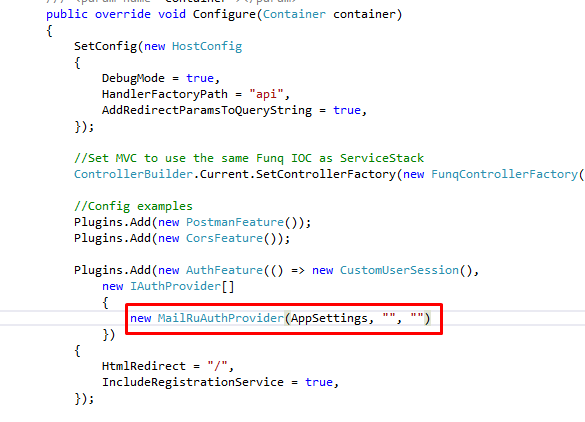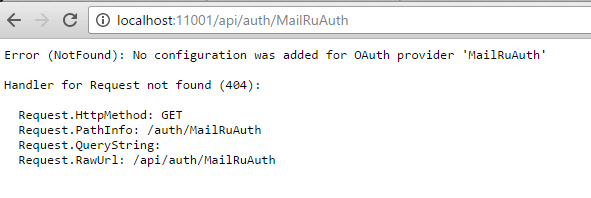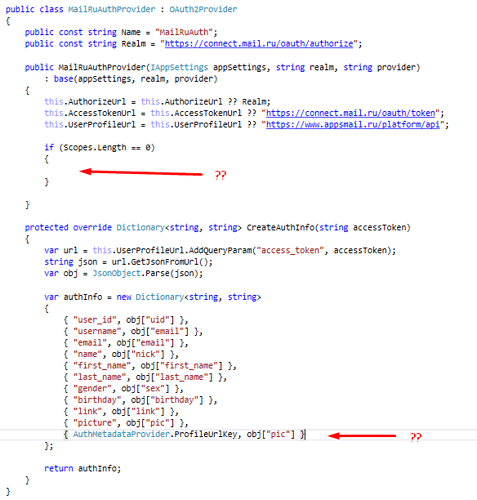I want to make a authorization mail.ru but can’t find provider.
someone knows how to connect mail.ru or how to configure a different provider?
Thanks!
Hi I just responded to this question on StackOverflow, i.e. would the existing implementations of:
Help you create a one?
I would be very grateful ))
That’s entirely dependent on each Auth Provider, who can use whatever scopes/permissions or return whatever info they like. The scopes are used to request Users permission for data/features they want access to.
For the scopes, I don’t understand Russian, but I believe they map to permissions listed at:
http://api.mail.ru/docs/guides/restapi/#permissions
The key for the AuthMetadataProvider.ProfileUrlKey is profileUrl, which should refer to an avatar or picture url of the User (if one is returned).
It turns out if I just need the authorization of the additional permissions I don’t need, and I can Scope left empty?
If Yes, then you’re all set, thank you very much!! ))
This is the code if someone will need:
public class MailRuAuthProvider : OAuth2Provider
{
public const string Name = "MailRuAuth";
public const string Realm = "https://connect.mail.ru/oauth/authorize";
public MailRuAuthProvider(IAppSettings appSettings, string realm, string provider)
: base(appSettings, realm, provider)
{
this.AuthorizeUrl = this.AuthorizeUrl ?? Realm;
this.AccessTokenUrl = this.AccessTokenUrl ?? "https://connect.mail.ru/oauth/token";
this.UserProfileUrl = this.UserProfileUrl ?? "https://www.appsmail.ru/platform/api";
if (this.Scopes.Length == 0)
{
this.Scopes = new[] {""};
}
}
protected override Dictionary<string, string> CreateAuthInfo(string accessToken)
{
var url = this.UserProfileUrl.AddQueryParam("access_token", accessToken);
string json = url.GetJsonFromUrl();
var obj = JsonObject.Parse(json);
var authInfo = new Dictionary<string, string>
{
{ "user_id", obj["uid"] },
{ "username", obj["email"] },
{ "email", obj["email"] },
{ "name", obj["nick"] },
{ "first_name", obj["first_name"] },
{ "last_name", obj["last_name"] },
{ "gender", obj["sex"] },
{ "birthday", obj["birthday"] },
{ "link", obj["link"] },
{ "picture", obj["pic"] },
{ AuthMetadataProvider.ProfileUrlKey, obj["pic_180"] }
};
return authInfo;
}
}Tell me please, how to enable the plugin?


You should be using the Name and Realm from your AuthProvider, e.g:
public class MailRuAuthProvider : OAuth2Provider
{
public const string Name = "mailru";
public const string Realm = "https://connect.mail.ru/oauth/authorize";
public MailRuAuthProvider(IAppSettings appSettings)
: base(appSettings, Realm, Name)
{
this.AuthorizeUrl = this.AuthorizeUrl ?? Realm;
this.AccessTokenUrl = this.AccessTokenUrl ?? "https://connect.mail.ru/oauth/token";
this.UserProfileUrl = this.UserProfileUrl ?? "https://www.appsmail.ru/platform/api";
}
protected override Dictionary<string, string> CreateAuthInfo(string accessToken)
{
var url = this.UserProfileUrl.AddQueryParam("access_token", accessToken);
string json = url.GetJsonFromUrl();
var obj = JsonObject.Parse(json);
var authInfo = new Dictionary<string, string>
{
{ "user_id", obj["uid"] },
{ "username", obj["email"] },
{ "email", obj["email"] },
{ "name", obj["nick"] },
{ "first_name", obj["first_name"] },
{ "last_name", obj["last_name"] },
{ "gender", obj["sex"] },
{ "birthday", obj["birthday"] },
{ "link", obj["link"] },
{ "picture", obj["pic"] },
{ AuthMetadataProvider.ProfileUrlKey, obj["pic_180"] }
};
return authInfo;
}
}
The name is then used in the auth route, i.e. /auth/mailru - I’m using mailru instead here for naming consistency.
No worries, note this impl will also be available in the next release from this commit 
Yeah typically if it’s just authentication you wont need additional scopes except if their default response doesn’t include the Users email (some don’t) and you need access to their email.

 very well, thanks!
very well, thanks!
Hi Demis!
Correct provider realization don’t correct, I fixed the bugs, this is a working version, please make commit 
Thanks a lot!
public class MailRuAuthProvider : OAuth2Provider {
public const string Name = "mailru";
public const string Realm = "https://connect.mail.ru/oauth/authorize";
public string Method { get; private set; }
public string Secure { get; private set; }
public MailRuAuthProvider(IAppSettings appSettings)
: base(appSettings, Realm, Name) {
Method = appSettings.GetString("oauth.{0}.Method".Fmt(Name));
Secure = appSettings.GetString("oauth.{0}.Secure".Fmt(Name));
this.AuthorizeUrl = this.AuthorizeUrl ?? Realm;
this.AccessTokenUrl = this.AccessTokenUrl ?? "https://connect.mail.ru/oauth/token";
this.UserProfileUrl = this.UserProfileUrl ?? "https://www.appsmail.ru/platform/api";
}
protected override Dictionary<string, string> CreateAuthInfo(string accessToken) {
var sig = CalcMd5("app_id={0}method={1}secure={2}session_key={3}{4}".
Fmt(new[] { base.ConsumerKey, Method, Secure, accessToken, base.ConsumerSecret }));
var url = this.UserProfileUrl
.AddQueryParam("method", Method)
.AddQueryParam("secure", Secure)
.AddQueryParam("app_id", base.ConsumerKey)
.AddQueryParam("session_key", accessToken)
.AddQueryParam("sig", sig);
var json = url.GetJsonFromUrl();
var objList = JsonSerializer.DeserializeFromString<List<Dictionary<string, string>>>(json);
if (objList.IsNullOrEmpty())
return null;
var obj = objList[0];
var authInfo = new Dictionary<string, string>
{
{ "user_id", obj["uid"] },
{ "username", obj["email"] },
{ "email", obj["email"] },
{ "name", obj["nick"] },
{ "first_name", obj["first_name"] },
{ "last_name", obj["last_name"] },
{ "gender", obj["sex"] },
{ "birthday", obj["birthday"] },
{ "link", obj["link"] },
{ "picture", obj["pic"] },
{ AuthMetadataProvider.ProfileUrlKey, obj["pic_180"] }
};
return authInfo;
}
private string CalcMd5(string input) {
var hashing = MD5.Create();
return ConvertToHexString(hashing.ComputeHash(Encoding.UTF8.GetBytes(input)));
}
private string ConvertToHexString(IEnumerable<byte> hash) {
var hexString = StringBuilderCache.Allocate();
foreach (byte byteFromHash in hash) {
hexString.Append($"{byteFromHash:x2}");
}
return StringBuilderCache.ReturnAndFree(hexString);
}
}ok I’ve cleaned up the code a bit and updated it in this commit.
Thank you! 
